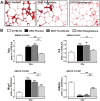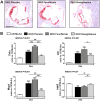PPAR agonist-induced reduction of Mcp1 in atherosclerotic plaques of obese, insulin-resistant mice depends on adiponectin-induced Irak3 expression
- PMID: 23620818
- PMCID: PMC3631170
- DOI: 10.1371/journal.pone.0062253
PPAR agonist-induced reduction of Mcp1 in atherosclerotic plaques of obese, insulin-resistant mice depends on adiponectin-induced Irak3 expression
Abstract
Synthetic peroxisome proliferator-activated receptor (PPAR) agonists are used to treat dyslipidemia and insulin resistance. In this study, we examined molecular mechanisms that explain differential effects of a PPARα agonist (fenofibrate) and a PPARγ agonist (rosiglitazone) on macrophages during obesity-induced atherogenesis. Twelve-week-old mice with combined leptin and LDL-receptor deficiency (DKO) were treated with fenofibrate, rosiglitazone or placebo for 12 weeks. Only rosiglitazone improved adipocyte function, restored insulin sensitivity, and inhibited atherosclerosis by decreasing lipid-loaded macrophages. In addition, it increased interleukin-1 receptor-associated kinase-3 (Irak3) and decreased monocyte chemoattractant protein-1 (Mcp1) expressions, indicative of a switch from M1 to M2 macrophages. The differences between fenofibrate and rosiglitazone were independent of Pparγ expression. In bone marrow-derived macrophages (BMDM), we identified the rosiglitazone-associated increase in adiponectin as cause of the increase in Irak3. Interestingly, the deletion of Irak3 in BMDM (IRAK3(-/-) BMDM) resulted in activation of the canonical NFκB signaling pathway and increased Mcp1 protein secretion. Rosiglitazone could not decrease the elevated Mcp1 secretion in IRAK3(-/-) BMDM directly and fenofibrate even increased the secretion, possibly due to increased mitochondrial reactive oxygen species production. Furthermore, aortic extracts of high-fat insulin-resistant LDL-receptor deficient mice, with lower adiponectin and Irak3 and higher Mcp1, showed accelerated atherosclerosis. In aggregate, our results emphasize an interaction between PPAR agonist-mediated increase in adiponectin and macrophage-associated Irak3 in the protection against atherosclerosis by PPAR agonists.
Conflict of interest statement
Figures







Similar articles
-
Peroxisome proliferator-activated receptor (PPAR)alpha activation increases adiponectin receptors and reduces obesity-related inflammation in adipose tissue: comparison of activation of PPARalpha, PPARgamma, and their combination.Diabetes. 2005 Dec;54(12):3358-70. doi: 10.2337/diabetes.54.12.3358. Diabetes. 2005. PMID: 16306350
-
Therapeutic potential of the dual peroxisome proliferator activated receptor (PPAR)α/γ agonist aleglitazar in attenuating TNF-α-mediated inflammation and insulin resistance in human adipocytes.Pharmacol Res. 2016 May;107:125-136. doi: 10.1016/j.phrs.2016.02.027. Epub 2016 Mar 11. Pharmacol Res. 2016. PMID: 26976796
-
A peroxisome proliferator-activated receptor alpha/gamma dual agonist with a unique in vitro profile and potent glucose and lipid effects in rodent models of type 2 diabetes and dyslipidemia.Mol Endocrinol. 2005 Jun;19(6):1593-605. doi: 10.1210/me.2005-0015. Epub 2005 Apr 14. Mol Endocrinol. 2005. PMID: 15831517
-
Impact of Peroxisome Proliferator-Activated Receptor Agonists on Myosteatosis in the Context of Metabolic Dysfunction-Associated Steatotic Liver Disease.Discov Med. 2024 Jun;36(185):1139-1153. doi: 10.24976/Discov.Med.202436185.104. Discov Med. 2024. PMID: 38926100 Review.
-
Nuclear receptors as targets for drug development: molecular mechanisms for regulation of obesity and insulin resistance by peroxisome proliferator-activated receptor gamma, CREB-binding protein, and adiponectin.J Pharmacol Sci. 2005 Feb;97(2):164-70. doi: 10.1254/jphs.fmj04008x2. Epub 2005 Feb 11. J Pharmacol Sci. 2005. PMID: 15725703 Review.
Cited by
-
Transcriptomic Insights into the Response of Placenta and Decidua Basalis to the CpG Oligodeoxynucleotide Stimulation in Non-Obese Diabetic Mice and Wild-Type Controls.Int J Mol Sci. 2016 Aug 5;17(8):1281. doi: 10.3390/ijms17081281. Int J Mol Sci. 2016. PMID: 27527166 Free PMC article.
-
Fibrates as drugs with senolytic and autophagic activity for osteoarthritis therapy.EBioMedicine. 2019 Jul;45:588-605. doi: 10.1016/j.ebiom.2019.06.049. Epub 2019 Jul 5. EBioMedicine. 2019. PMID: 31285188 Free PMC article.
-
New insights into the mechanisms and therapeutic strategies of chondrocyte autophagy in osteoarthritis.J Mol Med (Berl). 2024 Oct;102(10):1229-1244. doi: 10.1007/s00109-024-02473-1. Epub 2024 Aug 15. J Mol Med (Berl). 2024. PMID: 39145815 Review.
-
Adiponectin abates atherosclerosis by reducing oxidative stress.Med Sci Monit. 2014 Oct 2;20:1792-800. doi: 10.12659/MSM.892299. Med Sci Monit. 2014. PMID: 25275545 Free PMC article.
-
Changes in plasma IRAK-M in patients with prediabetes and its relationship with related metabolic indexes: a cross-sectional study.J Int Med Res. 2022 Aug;50(8):3000605221111275. doi: 10.1177/03000605221111275. J Int Med Res. 2022. PMID: 36039603 Free PMC article.
References
-
- Hotamisligil GS (2006) Inflammation and metabolic disorders. Nature 444: 860–867. - PubMed
Publication types
MeSH terms
Substances
LinkOut - more resources
Full Text Sources
Other Literature Sources
Medical
Molecular Biology Databases
Research Materials

